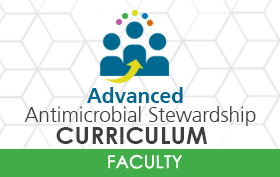
Section 2: Antimicrobial Stewardship Operations (Faculty)
Section 2: Antimicrobial Stewardship Operations
The content within Section 2 is directed at providing the steward - in - training with knowledge, skills, and resources to assess the current and ever-changing state of one’s Antimicrobial Stewardship Program(ASP). The mini-lectures within the first eLearning will introduce the concept of the Antimicrobial Stewardship Toolbelt. The application activities and workbooks are focused on having the learner apply the toolbelt to their local institution. It will also help them to learn about the importance of prioritization of initiatives and daily tasks.
This section contains 2 eLearnings, 5 application activities and 2 workbooks.
As the faculty or stewardship champion leading this effort, you can decide how the content is distributed and presented to your stewards- in- training.
For Stewards:
The fellow/trainee can watch the eLearning on their own, followed by a debrief between fellow and faculty.
For Faculty:
To present in a classroom or small group setting, there are two methods of delivery:
Method 1: | You can open the eLearning and let it talk for you, controlling the slides and the pace |
Method 2: | You can open the eLearning, disable the audio, and talk through the slides yourself |
How to Prepare in Advance:
- Review the eLearnings within Section 2
- Review both the fellow and faculty version for each of the workbooks
- Review the application activities
- Draft timeline of when to complete each component of Section 2
Target Audience
Program Directors, Antimicrobial Stewardship Faculty Champions, and additional Faculty responsible for leading and implementing the Advanced AS Curriculum.
Learning Objectives
Upon completion of this section, stewards- in- training will be able to:
- Analyze local institutional data (e.g. antimicrobial use and resistance patterns) to identify impactful local stewardship initiatives
- Demonstrate an understanding of where to focus on changing practice and how to identify “low hanging fruit”
- Prioritize antimicrobial stewardship initiatives (e.g. electronic alerts, restricted antimicrobial approval) into a productive, feasible daily workflow designed to meet local institutional needs
- Identify methods to use EHS to support AS activities
- Manage non-formulary drug requests (P & T considerations)
- Describe systematic approaches to improving antimicrobial use in the major “infection syndromes” where antimicrobials are over- and misused
- Create and update local treatment guidelines using local antibiogram data

 Facebook
Facebook X
X LinkedIn
LinkedIn Forward
Forward